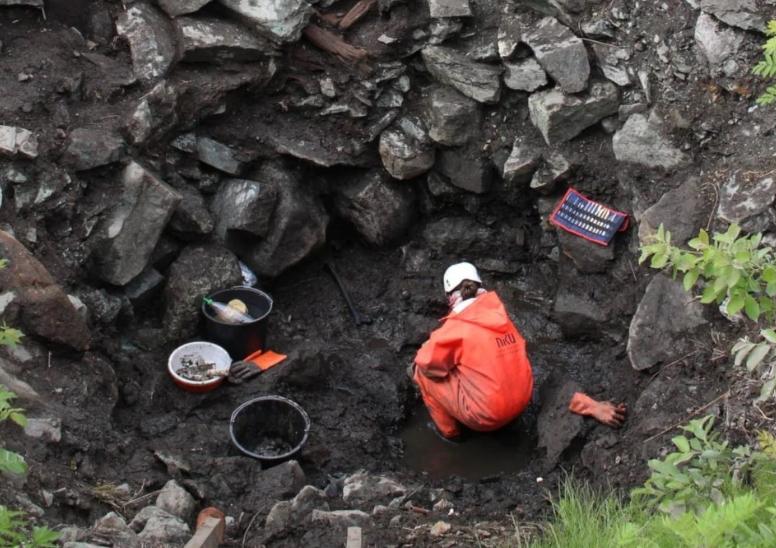In 1938, an excavation at the ruins of King Sverre Sigurdsson’s castle in Sverresborg, Norway, revealed a striking archaeological find: an 800-year-old skeleton at the bottom of an ancient well. Known today as the “Well Man,” this skeleton presents an enigmatic piece of Norway’s medieval history, intertwined with a tale of siege warfare, early biological tactics, and the enduring mystery of identity. Through recent scientific analysis, researchers have been able to uncover aspects of the “Well Man’s” past and provide insight into the brutal methods of medieval conflict.
Discovery of the Well Man: An Unexpected Find
The excavation of Sverresborg Castle in 1938 uncovered a set of human remains at the bottom of a well, an unexpected and, at the time, largely ignored discovery. World War II and limited forensic technology prevented further study of the skeleton. For decades, it lay in obscurity, a relic of medieval Norway whose significance was not fully recognized until recent advances in archaeology made further analysis possible.

Historical Context: The Siege and the Sverris Saga
The 12th-century Sverris Saga, a medieval text chronicling the life and battles of King Sverre Sigurdsson, provides clues that bring the “Well Man” into the narrative of medieval warfare. According to the saga, Sverre’s forces clashed repeatedly with the rival Bagler faction, who allegedly employed unconventional tactics to weaken Sverre’s strongholds. The saga recounts that during a siege, the Baglers threw a body into a well to poison its water supply, forcing the defenders to abandon it. This strategic act could be one of the earliest instances of biological warfare recorded in European history, marking a grim chapter in the tale of Norway’s medieval conflicts.
Identity and Origins: The Power of DNA Analysis
Recent advancements in DNA technology have allowed researchers to analyze the “Well Man’s” remains and unearth clues about his identity. DNA analysis indicates that he was of southern Norwegian ancestry, suggesting he may have been either a soldier in Sverre’s forces or a local captured by the Baglers. Surprisingly, his genetic background shows similarities to some of the Baglers themselves, raising questions about shifting alliances or even familial connections across enemy lines during the civil wars of that era.
The study further revealed signs of trauma on the skeleton, consistent with a violent death. These injuries suggest that he may have been subjected to brutal treatment before being discarded into the well, potentially confirming the saga’s account of his death at the hands of Sverre’s enemies.
Theories and Interpretations: Revisiting the “Biological Warfare” Tactic
Historians and archaeologists view the act of throwing a body into a well as an early form of biological warfare, aiming to contaminate the water supply and weaken the castle’s defenses. Such tactics reflect a harsh reality of medieval warfare, where survival often depended on outmaneuvering the enemy by any means necessary. While the Sverris Saga may have exaggerated or altered details for dramatic effect, the discovery of the “Well Man” supports its account of the siege and highlights the extreme strategies used in conflicts over control and resources.

The Significance of the Well Man: A Legacy Unearthed
The “Well Man” is more than a skeleton; he is a physical link to the past, a testament to the lives lost and the brutal strategies employed during Norway’s medieval period. His rediscovery highlights the importance of revisiting historical artifacts with modern technology, as each new analysis can breathe life into forgotten histories and reframe our understanding of the past.
Conclusion: Bringing the Past to Life
As the “Well Man” is examined further, he continues to shed light on the grim realities of medieval warfare, survival, and the lengths to which people would go to claim victory. Through scientific analysis, researchers have pieced together fragments of his life, connecting him to the siege of Sverresborg Castle and the fierce conflicts between the Baglers and King Sverre’s forces. His tragic fate reminds us of the personal sacrifices made during Norway’s turbulent medieval era and serves as a powerful reminder of how historical and scientific inquiry can bring ancient stories to life once more.
In this way, the “Well Man” has moved from being an obscure relic to an emblem of human history, bridging the past and present through archaeology and the science of DNA. His story, once lost to time, now resonates as a poignant reflection on the resilience, struggle, and enduring legacy of those who lived in an age long gone.
